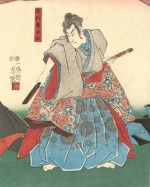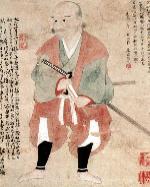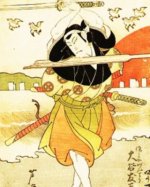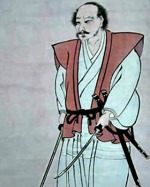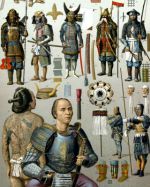Tomoe Gozen – Female Samurai Warrior
Talk the Talk
Female samurai warriors like Tomoe Gozen were known as Onna-bugeisha. They would train in the fighting arts, however, few would actually fight on the battlefield.
Instead, they would use their skills to defend the home and family while the men of the household were absent, especially in times of war.
Instead, they would use their skills to defend the home and family while the men of the household were absent, especially in times of war.
Walk the Walk
One of Tomoe’s weapons of choice was the Naginata, which consisted of a wooden shaft with a curved blade on the end and was ideal for stabbing, hooking or bludgeoning an opponent to death.
By the 16th century, the Naginata was a symbolic weapon for female members of the samurai class, though they seldom actually fought.
By the 16th century, the Naginata was a symbolic weapon for female members of the samurai class, though they seldom actually fought.
Samurai Quote
"Tomoe had long black hair and fair complexion, and her face was very lovely; moreover she was a fearless rider, whom neither the fiercest horse nor the roughest ground could dismay, and so dexterously did she handle sword and bow that she was a match for a thousand warriors, and fit to meet either god or devil.
Many times she had taken the field, armed at all points, and won matchless renown in encounters with the bravest captains, and so in this last fight, when all the others had been slain or fled, among the last seven there rode Tomoe".
~ The Heike Monogatari ~
Many times she had taken the field, armed at all points, and won matchless renown in encounters with the bravest captains, and so in this last fight, when all the others had been slain or fled, among the last seven there rode Tomoe".
~ The Heike Monogatari ~
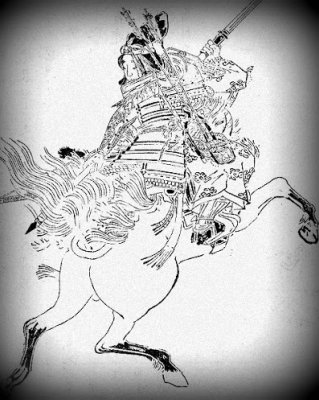 Tomoe Gozen appears in Japanese samurai chronicles from the latter half of the twelfth century and probably lived from around 1157 to around 1247 CE. While there is much variation on the stories concerning her, the texts are clear that Tomoe was one of the best martial arts practitioners of her day and was famed as a warrior of formidable skill.
Tomoe Gozen appears in Japanese samurai chronicles from the latter half of the twelfth century and probably lived from around 1157 to around 1247 CE. While there is much variation on the stories concerning her, the texts are clear that Tomoe was one of the best martial arts practitioners of her day and was famed as a warrior of formidable skill.Tomoe Gozen’s Battles
As one of the few female samurai legends, Tomoe has earned her place in martial arts history however how much of the accounts of her are actually true is impossible to tell. It is certainly plausible at least that Tomoe did learn martial arts and had a unique opportunity to use her skills.She is famed for going into battle alongside the samurai warrior Minamoto Yoshinaka, whom she served with absolute loyalty; according to some sources she was also his mistress or even his wife. They fought together in the Gempei War (1180 – 1185) at the end of the Heian Period, which she is believed to have survived, unlike her master Yoshinaka.
In one battle, she is reported to have single-handedly defended a bridge against dozens of attackers.
In another, she is said to have killed many samurai warriors one after another in single combat and then killed their leader, Uchida Iyeyoshi. Attempting to drag her from her horse, Uchida infuriated Tomoe who promptly decapitated him and delivered his head as a trophy to Yoshinaka. Her most famous story is from the Battle of Awazu (1184) where Yoshinaka was finally defeated by his enemies. When the battle was lost, Yoshinaka told Tomoe he would fight to the death but she should leave the battlefield as he would be shamed to die fighting with a woman; after killing another opposing samurai warrior, she complied and escaped.
However, as she left the field, she was attacked by an enemy soldier named Wada Yoshimori. He appeared to have lost his samurai sword as he used a pine trunk as a club to attack her. She twisted and broke it but was overpowered and forced to become Wada’s concubine. She had a son with him who, it is said, was killed in 1213 when the Hojo family destroyed the Wada family. After this, Tomoe is said to have become a nun and lived to the age of ninety-one.
Other sources end the story of one of the most formidable female warriors in the history of the martial arts differently. Some say she killed many enemies before leaving the Battle of Awazu, then retired to a temple and took holy orders. Others have it that after leaving the battlefield she committed seppuku, a form of self-disembowelment a warrior would inflict with his (or her) own samurai sword to avoid the disgrace of capture. Others still say that she retrieved Yoshinaka’s head from the battlefield and walked with it out into the sea, bringing about her own death so as to continue to serve her master in the afterlife.
After the Fighting
Tomoe Gozen is unique as she is the only female warrior who is described in detail in the ancient Japanese samurai war tales. The Heike Monogatari does not mention her again after she leaves the Battle of Awazu but according to another source, the Gempei Seisuki, she had been ordered by Yoshinaka to go to his home province and tell the story of his final battle in a bid to make his exploits a become a part of samurai legend.However, as she left the field, she was attacked by an enemy soldier named Wada Yoshimori. He appeared to have lost his samurai sword as he used a pine trunk as a club to attack her. She twisted and broke it but was overpowered and forced to become Wada’s concubine. She had a son with him who, it is said, was killed in 1213 when the Hojo family destroyed the Wada family. After this, Tomoe is said to have become a nun and lived to the age of ninety-one.
Other sources end the story of one of the most formidable female warriors in the history of the martial arts differently. Some say she killed many enemies before leaving the Battle of Awazu, then retired to a temple and took holy orders. Others have it that after leaving the battlefield she committed seppuku, a form of self-disembowelment a warrior would inflict with his (or her) own samurai sword to avoid the disgrace of capture. Others still say that she retrieved Yoshinaka’s head from the battlefield and walked with it out into the sea, bringing about her own death so as to continue to serve her master in the afterlife.
What really happened to Tomoe Gozen both before and after the battle of Awazu will probably never be known for sure but it is probable that she not only existed, but played some part in the Gempei War. This makes her a rarity in the history of fighting, as a woman making a difference in the traditionally male world of martial arts and warrior history.
Henshall, K. 2004. Second Edition. A History of Japan – From Stone Age to Super Power. Hampshire. MacMillan Press.
Jones, D. E. Second Edition. 2005. Women Warriors – A History. Brassey's Inc. USA.
The Samurai of the Heian Period (794 – 1185). [Internet]. 2009. Socyberty.com. Available from http://socyberty.com/military/the-samurai-of-the-heian-period-794-1185/ [Accessed November 28, 2012]
Turnbull, S. 2008. The Samurai Swordsman – Master of War. Tuttle Publishing. UK.
Written by Andrew Griffiths – Last updated 24/10/2023. If you like
what you see, consider following the History of Fighting on social media.
Further Reading:
Bryant,A.J. 1991. Early Samurai: 200 – 1500 AD. Via Google Books. Available from: http://books.google.co.uk/books?id=FxTNBAAJaqEC&printsec=frontcover&dq=Early+samurai&hl=en [Accessed November 27, 2012].Henshall, K. 2004. Second Edition. A History of Japan – From Stone Age to Super Power. Hampshire. MacMillan Press.
Jones, D. E. Second Edition. 2005. Women Warriors – A History. Brassey's Inc. USA.
The Samurai of the Heian Period (794 – 1185). [Internet]. 2009. Socyberty.com. Available from http://socyberty.com/military/the-samurai-of-the-heian-period-794-1185/ [Accessed November 28, 2012]
Turnbull, S. 2008. The Samurai Swordsman – Master of War. Tuttle Publishing. UK.
More Samurai History
Samurai History Home
A brief overview of the history of the samurai, looking at the rise and development of the leading social class in Japan and some of the cultural traits than made the samurai warriors unique such as their weapons and their code of ethics, known as bushido.
A brief overview of the history of the samurai, looking at the rise and development of the leading social class in Japan and some of the cultural traits than made the samurai warriors unique such as their weapons and their code of ethics, known as bushido.
The Heian Period
The Heian Period was a time of major change in Japan as it saw the rise of a new warrior elite, the Samurai. The leaders of this new power would dominate the politics of the country for centuries and would even supplant the power of the Emperor, though not without a struggle.
The Heian Period was a time of major change in Japan as it saw the rise of a new warrior elite, the Samurai. The leaders of this new power would dominate the politics of the country for centuries and would even supplant the power of the Emperor, though not without a struggle.
Yoshitsune Minamoto
The tragic tale of samurai legend Yoshitsune Minamoto. After helping his brother Yoritomo win the Genpei War and gain control of Japan, he was denied the titles and rewards he should have received for his services and was ultimately hunted down as a traitor.
The tragic tale of samurai legend Yoshitsune Minamoto. After helping his brother Yoritomo win the Genpei War and gain control of Japan, he was denied the titles and rewards he should have received for his services and was ultimately hunted down as a traitor.
The Kamakura Period
A look at the change and turmoil experienced by the ruling elite of Japan during the Kamakura Period and the Kemmu Restoration. A series of civil wars and two invasions from the Mongols saw powershifts not only between rival families, but also between the titles of the Emperor, the Shogun and the Regent.
A look at the change and turmoil experienced by the ruling elite of Japan during the Kamakura Period and the Kemmu Restoration. A series of civil wars and two invasions from the Mongols saw powershifts not only between rival families, but also between the titles of the Emperor, the Shogun and the Regent.
The Mongols vs. The Samurai
While the samurai warriors of the late thirteenth century were formidable warriors in their own right, when faced with the onslaught of the Mongol Hordes they seemed to be fated to lose. They were outclassed in every way by however things did not go according to plan for the foreign invaders.
While the samurai warriors of the late thirteenth century were formidable warriors in their own right, when faced with the onslaught of the Mongol Hordes they seemed to be fated to lose. They were outclassed in every way by however things did not go according to plan for the foreign invaders.
The Japanese Samurai Sword
The samurai sword, it is said, was believed to contain the soul of the warrior who owned it. While this is probably an over romanticised view, it is true to say that there was a spiritual connection not only for the wielder of the katana, but also for the sword smith and his creation.
The samurai sword, it is said, was believed to contain the soul of the warrior who owned it. While this is probably an over romanticised view, it is true to say that there was a spiritual connection not only for the wielder of the katana, but also for the sword smith and his creation.
The Muromachi Period
The Muromachi Period was a time of turmoil in Japan that can be spilt into two separate eras. At the beginning of the period, the government was divided into two separate entities sparking the Northern and Southern Courts Era. Then, after a brief period of relative stability, the Warring States Era began.
Tsukahara Bokuden
Tsukahara Bokuden was a samurai warrior who lived in the 16th century. In his early days he exemplified what a samurai should be and was known as one of the fiercest warriors around. However in later life, Bokuden would take on a more pacifist philosophical stand point.
Tsukahara Bokuden was a samurai warrior who lived in the 16th century. In his early days he exemplified what a samurai should be and was known as one of the fiercest warriors around. However in later life, Bokuden would take on a more pacifist philosophical stand point.
The Death of a Samurai
The manner in which a samurai died was very important and if possible, it would be during combat in a way that would be told in samurai stories for years to come. Failing that, he should die in some other service to his lord or if his honour depended on it, in a ritualistic suicide known as seppuku.
The manner in which a samurai died was very important and if possible, it would be during combat in a way that would be told in samurai stories for years to come. Failing that, he should die in some other service to his lord or if his honour depended on it, in a ritualistic suicide known as seppuku.
The Duels of Miyamoto Musashi
Miyamoto Musashi is one of the most acclaimed samurai that ever lived. While undertaking a warrior’s pilgrimage, he fought in over 60 duels dispatching the best swordsmen in a given area, often in fights to the death.
The Samurai at War
The main business of the samurai was war and while tactics and weapons changed through the years, the willingness to die for their lord was a constant. In return, they could gain riches and status, as well as the best of them gaining a kind of immortality by having stories told about them for centuries to come.
The main business of the samurai was war and while tactics and weapons changed through the years, the willingness to die for their lord was a constant. In return, they could gain riches and status, as well as the best of them gaining a kind of immortality by having stories told about them for centuries to come.
The images on this site are believed to be in the public domain, however, if any mistakes have been made and your copyright or intellectual rights have been breeched, please contact andrew@articlesonhistory.com.

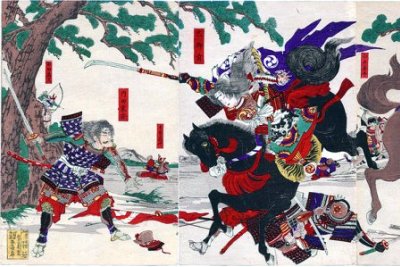
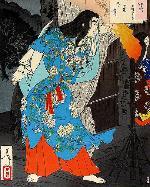
.jpg?timestamp=1583831614211)
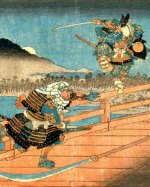
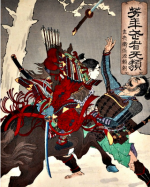
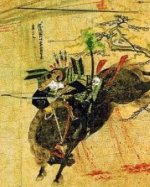
 thumb.jpg?timestamp=1583832044418)
